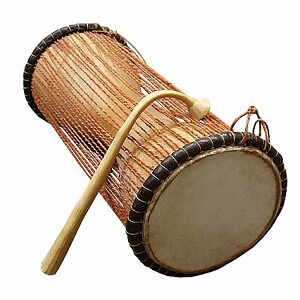Talking Drum
 Talking drum, any of various types of drums that, by imitating the rhythm and the rise and fall of words in languages, are used as communication devices. Such drums occur in East and West Africa, Melanesia, and Southeast Asia.
Talking drum, any of various types of drums that, by imitating the rhythm and the rise and fall of words in languages, are used as communication devices. Such drums occur in East and West Africa, Melanesia, and Southeast Asia.
Five varieties of dùndún pressure drums of the Yoruba and the atumpan and fontomfrom of the Asante (Ashanti) are especially notable. They send messages up to 20 miles (32 km), where other drummers relay them, quickly spreading tribal news.
To play, the drummer tucks the drum under his arm and taps the head with his hand and a hook shaped drumstick. To mimic the stresses and intonations of speech, the drummer simply squeezes the drum between his arm and body, causing the leather cords,or ropes, to change shape.
Uses for the talking drum are as diverse as the cultures that utilize it. While it can be played for ceremonial purposes or as entertainment, the real significance of the talking drum lies in the role it plays in communication. In its earliest form, the talking drum served as an aid to ancient Griot or storytellers. These traveling poets and musicians would use the talking drums to carry on the oral traditions of their cultures.